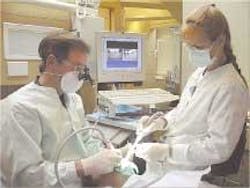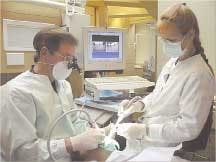Special deliveries
The selection of operatory delivery units may occur two or three times during your career and it is typically in the context of equipping a new or remodeled facility. It is the single-most important decision you will make in determining the functionality of (or lack of) an operatory. For the remainder of your career, the only time you will contemplate this issue is when you step on a rheostat and nothing happens.
What is a delivery unit? It is a complex mechanism designed to “deliver” compressed air, vacuum, water, and power to the operator and assistant for use in pneumatic handpieces, air-water syringes, high-volume evacuators, saliva ejectors, and smaller pieces of dental equipment requiring a power supply.
With the proliferation of dental technology over the last decade, many manufacturers have also chosen to integrate devices such as intraoral cameras, air abrasion units, ultrasonic scalers, electrosurgical devices, and curing lights into their delivery units. The functional expansion of the delivery unit - to include all devices that terminate in wand-like implements designed for insertion in the oral cavity - is theoretically a great idea. In reality, from my perspective, the idea is flawed and I do not recommend this approach.
The traditional components of the unit (compressed air, vacuum, water, and power) are typically manufactured by companies such as A-dec, Pelton & Crane, DentalEZ, and others. These companies train reseller networks of service technicians and have long histories of supporting their products. The same cannot be said of the newer technology products because they are “new.” It would be disappointing to have great functioning delivery units from one manufacturer that also integrate defunct intraoral cameras and air abrasion units originally from different manufacturers that have subsequently gone out of business. For example, the individual purchase of a stand-alone LED intraoral camera will always be significantly less than that same camera integrated into a delivery unit as a joint venture between two companies. In well-designed operatories, it should be relatively easy to position a stand-alone intraoral camera wand near the oral cavity on a hanger clasp attached to cabinetry or a supporting work surface, eliminating the impetus to combine it with the delivery unit.
From this point forward, please assume any reference to delivery units assumes only the traditional components of compressed air, vacuum, water, and power. There are many configurations of delivery units available to you. The following are my configuration recommendations and how they impact the delivery of dental treatment.
Recommended types of delivery unit combinations
Flexible rear delivery with dual function - This configuration combines the doctor and assistant modules and a work surface to the same unit. Ambidextrous cart or wall-mount units are available. High-quality examples include A-dec 2671 and 3171 and the Pelton & Crane Model 2402 and Model 2800. I prefer the cart-based units due to lower cost and ease of installation. Doctor’s module positioning allows an assistant to change burs and pass handpieces to the operator. A movable work surface set at 32 to 34 inches above the floor promotes proper instrument transfers to and from the oral cavity. The above-mentioned A-dec and Pelton & Crane units are ambidextrous and can quickly be repositioned to support right-handed or left-handed operators (see photo above).
Split delivery - Split delivery units separate the doctor’s module from the assistant’s module. As an operator, if you must retrieve your own handpieces and change your own burs, I recommend considering a split system to facilitate that directive. There are a few variations of split delivery that include side delivery units. Unfortunately, side delivery units convert operatories to either right-handed or left-handed rooms and should be avoided. The side delivery unit also limits the side cabinet function that may house the unit.
Examples of split delivery systems that are viable options for you would be:
* A-dec 532 Traditional (doctor’s module attached to patient chair) paired with either the A-dec 2615 Assistant’s Cart or A-dec 3175 Assistant’s Wall Mount.
* A-dec 533 Continental (“buggy whip” doctor’s module attached to patient chair) paired with either the A-dec 2615 Assistant’s Cart or A-dec 3175 Assistant’s Wall Mount.
* Pelton & Crane Spirit 2000 Ellipse Model 2120 paired with either Spirit 2000 Model 2412 Assistant’s Cart or Spirit 2000 Model 2811 Wall Mount.
The continental (buggy whip) style can be especially intimidating to the patient because that module must be positioned over the patient’s chest or the buggy whip extension will not reach to the oral cavity. The upside to the continental style unit is that it creates the least amount of “pull-back” on your handpieces and can be very helpful to those of you with wrist and hand soreness issues.
Hygiene delivery - For many years, we equipped all operatories in a facility with identical delivery unit configurations. With all operatories equipped identically, the rationale is that hygiene and operative procedures can be delivered in any operatory, providing maximum scheduling efficiency. In the past, most of these identically equipped operatories were flexible rear delivery with dual function. Unfortunately, over the years, many hygienists have reacted negatively to the flexible rear delivery dual function configuration units due to the difficulty of retrieving instruments from behind their seated position. For example, a right-handed hygienist seated at 11 or 12 o’clock would have to constantly torque back to the 1 o’clock position to obtain instruments.
To assist hygienists - a very productive and valuable component of any general practice facility - I recommend designating as many operatories as “hygiene” as you have hygienists working at the same time during your practice day. You can still perform basic operative procedures in the “hygiene” operatories, but they are reconfigured to support hygiene treatment delivery.
The hygiene design rationale is based on positioning all instruments in front of the seated hygienist for ease of retrieval. This would include the handpiece(s), air-water syringe, HVE, saliva ejector, and primary tray containing all static hand instruments.
A great example of an operatory delivery unit configuration that supports hygiene treatment - but can also work for basic operative procedures - is the A-dec 532 Traditional with attached instrument tray paired with the A-dec 551 Long Assistant’s arm with attached instrument tray. This configuration is the ultimate in wrapped work surface and instruments support for an unassisted hygienist delivering care.
Author’s Note: Visit www.a-dec.com and www.pelton.net to view these options and others to get more information. Many other manufacturers such as DentalEZ, Marus, Belmont, Midmark, Dentech, and Forrest make configurations analogous to these examples and are worthy of your consideration.
Dr. Jeff Carter is co-owner of the Practice Design Group, based in Austin, Texas. PDG specializes in providing architectural, interior design and equipment, and technology integration services to dentists nationwide. Dr. Carter may be reached at (512) 295-2224 or by e-mail at [email protected].

